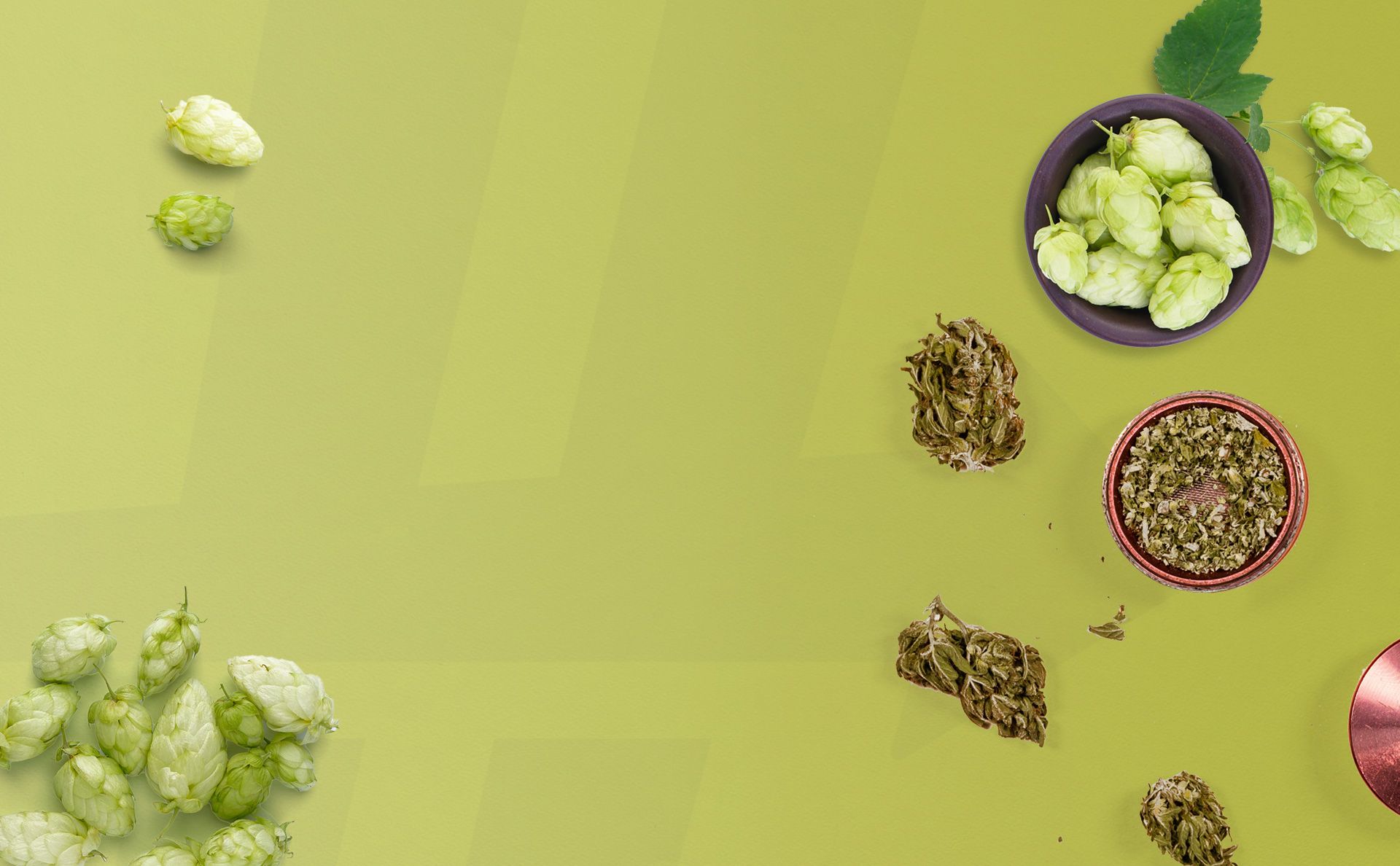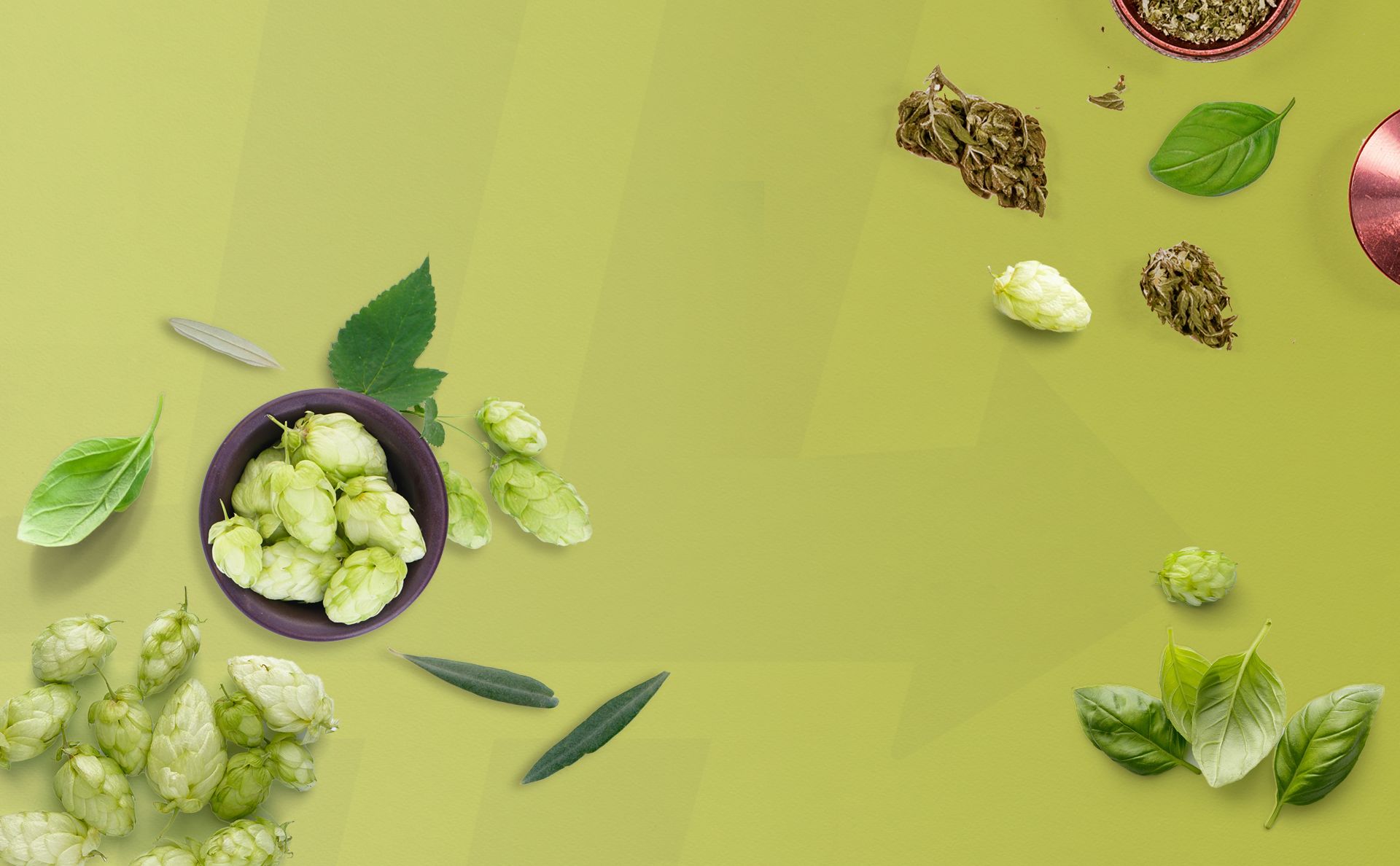Humulene
Humulene is an interesting and recognizable terpene abundant in many herbs and spices like hops that are used to brew beer. Here, we discuss what cultivars containing humulene taste like and smell. Additionally, we cover whether this terpene offers any potential medical benefits when sourced from plants in our natural world.

What is Humulene? In this chapter, we discuss the flavor, aroma, and potential benefits of this terpene.
What is Humulene?
Pronounced “whom-u-leen,” the terpene humulene is hop's most prominent terpene, instantly recognizable by craft beer aficionados. For those who don't drink, you can think of the intensely earthy smell of hummus. Humulene is also found in plants like ginseng, basil, black pepper, and sage, in more abundant quantities of up to 40% of total terpene composition.
Humulene is technically alpha-caryophyllene, a structural relative (isomer) of beta-caryophyllene. This explains why both are found in the same sources and similar therapeutic potential. Unfortunately, this also makes it difficult to parse out humulene’s distinct effects in research.
In cannabis, humulene is one of the top eight most common terpenes, found in the majority of cannabis chemovars. Humulene offers earthy and woody flavors and aromas, with hints of spicy notes. Much like many other terpenes, humulene is abundant in many plants and has been consumed holistically for centuries in foods and herbal preparations.
Terpene Flavor and Aroma Profile: Humulene
Humulene’s flavor and aroma are uniquely woody, earthy, and slightly spicy, which is a perfect combination for brewer’s hops. Humulene is perhaps the terpene that cannabis and beer share the most, as this compound is responsible for the delicious flavor profiles of some of the best craft brews and cannabis.
In fact, humulene is named after Humulus lupulus, which is basically the hops plant. Hops are also part of the hemp family Cannabacae, just like Cannabis sativa, indica and ruderalis.

Similarly, humulene is a structural relative of the fellow terpene beta-caryophyllene, and the two compounds share similar flavor and aroma profiles. Both humulene (alpha-caryophyllene) and beta-caryophyllene are prominent in pungent and slightly spicy plants like clove, basil, and sage.

What the expert says...
Dr. Abraham Benavides
"The most prominent terpene in hops, humulene is also found in plants like basil, ginseng, and sage. In cannabis, humulene is also commonly abundant and has earthy and woody flavors and aromas, with hints of spicy notes."
Cultivars with the Terpene Humulene
Humulene is abundant in the majority of cannabis cultivars, responsible for giving herbaceous and slightly spicy flavor profiles to your favorite varieties. There are also slightly floral aromas from many cultivars containing high levels of humulene. Although humulene can be found in most cultivars, it often takes a back seat to the more dominant terpenes like myrcene.
Some of the most popular cultivars that contain noticeable amounts of humulene include:
Does Humulene Get You High?
No, humulene does not get you high. Humulene may play a role in the entourage effect in more ways than one.
There is new research showing synergistic psychotropic potential of certain terpenes. Sadly, humulene is not included due to not being practically dissolvable (soluble) enough to study. However, its isomer beta-caryophyllene has some potentiating effect at CB1, so it’s still plausible that humulene may also contribute to THC’s effects.
This means that humulene may have a subtle impact on the consumer when combined with other compounds in whole-plant cannabis, like cannabinoids and other terpenes. As is the case with so many other aspects of cannabis, more research is needed to determine this, and each consumer responds differently.
Potential Benefits of Humulene
Research into the possible benefits of humulene is limited to preclinical studies, meaning those done in animals and test tubes. It's also limited by the fact that it's very difficult to isolate, and so it can’t really be studied on its own. Since it's nearly identical to caryophyllene, it shares many of the same potential therapeutic applications.
Here are some highlights of the limited information we know about humulene-dominant preparations in preclinical studies:
- Anti-inflammatory
- Antiasmatic and lung-protective
- Antibacterial against enterotoxigenic Bacteroides fragilis, which causes inflammatory bowel disease
- Pain-relieving and anti-neuropathic
- Chemosynergistic
- Anti-tumor effects, including on liver cancer cells, ovarian cancer cells, lymphoblast cancer cells, breast cancer cells, and colon cancer cells
- Gastroprotective
Note that it’s also hard to study humulene on its own because in concentrated forms it may irritate the skin, eyes, and mucous membranes, including the respiratory tract. You should never take pure, concentrated, undiluted, or synthetic terpenes due to potentially serious adverse effects. However, terpenes in naturally-occurring amounts in plants are known to be safe.
What We Learned: Humulene
Humulene is responsible for some of the best flavor and aroma profiles in both cannabis and craft beer. Here’s what we learned about the terpene humulene in this chapter:
- Humulene’s flavor and aroma are uniquely woody, earthy, and slightly spicy, which is a perfect combination for brewer’s hops.
- Humulene is the terpene in hops that shares the most in common with cannabis, as this compound is responsible for the flavor profiles of some of the best craft brews and cannabis.
- Humulene is named after Humulus lupulus, which is basically the hops plant.
- Humulene (alpha-caryophyllene) is a relative of the fellow terpene beta-caryophyllene, and the two compounds share similar flavor, aroma, sources, and potential therapeutic profiles.
- Both humulene and caryophyllene are prominent in pungent and slightly spicy plants like black pepper, hops, clove, basil, ginseng, and sage.
- Some of the most popular cultivars that contain humulene include Death Star, Gelato, GSC, Sour Diesel, Jack Here, Chemdawg, and Sherbert.
- Some potential benefits of humulene include anti-inflammatory, anti-asthmatic, antibacterial, analgesic, and some anticancer activity.
As we continue to see cannabis research progress forward, we could see the known benefits of terpenes like humulene increase.
If you're ready for another chapter in our terpenes guide, answer the question below, and let's keep moving.
Citations
- Benavides, A. (2022, April 28). Humulene—Terpenes and Cannabinoid Research. Cannakeys.https://cannakeys.com/humulene-terpene-research/
- Chen, H., Yuan, J., Hao, J., Wen, Y., Lv, Y., Chen, L., & Yang, X. (2019). α-Humulene inhibits hepatocellular carcinoma cell proliferation and induces apoptosis through the inhibition of Akt signaling. Food and Chemical Toxicology, 134, 110830.https://doi.org/10.1016/j.fct.2019.110830
- Fidyt, K., Fiedorowicz, A., Strządała, L., & Szumny, A. (2016). β‐caryophyllene and β‐caryophyllene oxide—Natural compounds of anticancer and analgesic properties. Cancer Medicine, 5(10), 3007.https://doi.org/10.1002/cam4.816
- Jang, H.-I., Rhee, K.-J., & Eom, Y.-B. (2020). Antibacterial and antibiofilm effects of α-humulene against Bacteroides fragilis. Canadian Journal of Microbiology, 66(6), 389–399.https://doi.org/10.1139/cjm-2020-0004
- Liktor-Busa, E., Keresztes, A., LaVigne, J., Streicher, J. M., & Largent-Milnes, T. M. (2021). Analgesic Potential of Terpenes Derived from Cannabis sativa. Pharmacological Reviews, 73(4), 1269–1297.https://doi.org/10.1124/pharmrev.120.000046
- Raz, N., Eyal, A. M., Zeitouni, D. B., Hen-Shoval, D., Davidson, E. M., Danieli, A., Tauber, M., & Ben-Chaim, Y. (2023). Selected cannabis terpenes synergize with THC to produce increased CB1 receptor activation. Biochemical Pharmacology, 212, 115548.https://doi.org/10.1016/j.bcp.2023.115548
- Rogerio, A. P., Andrade, E. L., Leite, D. F., Figueiredo, C. P., & Calixto, J. B. (2009). Preventive and therapeutic anti-inflammatory properties of the sesquiterpene α-humulene in experimental airways allergic inflammation. British Journal of Pharmacologhttps://doi.org/10.1111/j.1476-5381.2009.00177.x
- Xu, Y., Luo, J., Guo, Y., Zhou, J., Shen, L., Gu, F., Shi, C., Yao, L., & Hua, M. (2024). Chemical compounds, anti-tumor and anti-neuropathic pain effect of hemp essential oil in vivo. Fitoterapia, 177, 106092.https://doi.org/10.1016/j.fitote.2024.106092
- Yeo, D., Hwang, S.-J., Song, Y.-S., & Lee, H.-J. (2021). Humulene Inhibits Acute Gastric Mucosal Injury by Enhancing Mucosal Integrity. Antioxidants, 10(5), 761.https://doi.org/10.3390/antiox10050761
Test your knowledge, track your progress and earn your badge.
Humulene is a relative of which terpene?

Dr. Abraham Benavides
Dr. Abraham Benavides is an internationally-recognized cannabis research expert, experienced medical advisor, and full-tuition merit scholar of the George Washington University School of Medicine and Health Sciences. Dr. Abe enjoys helping patients as a writer, educator, and cannabis health coach at the GW Center for Integrative Medicine.